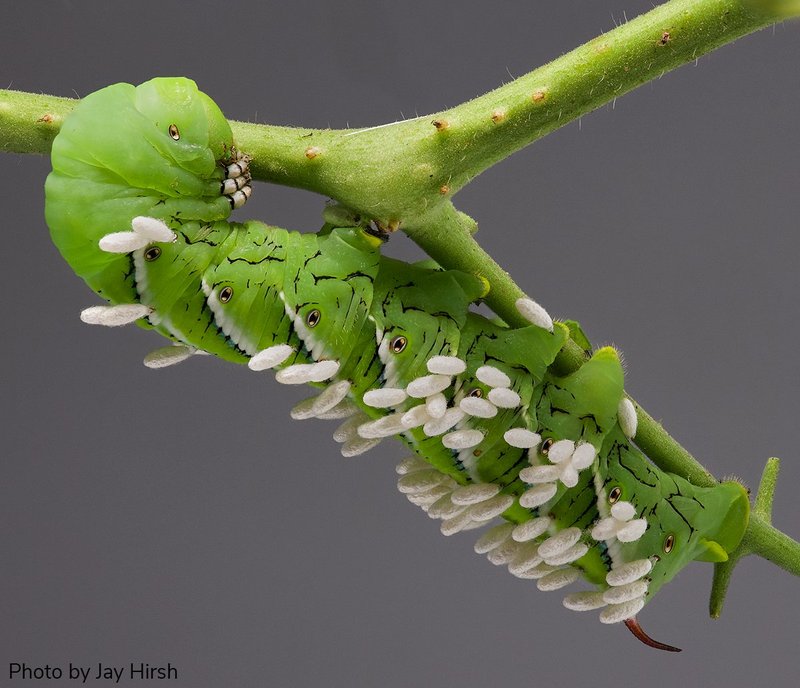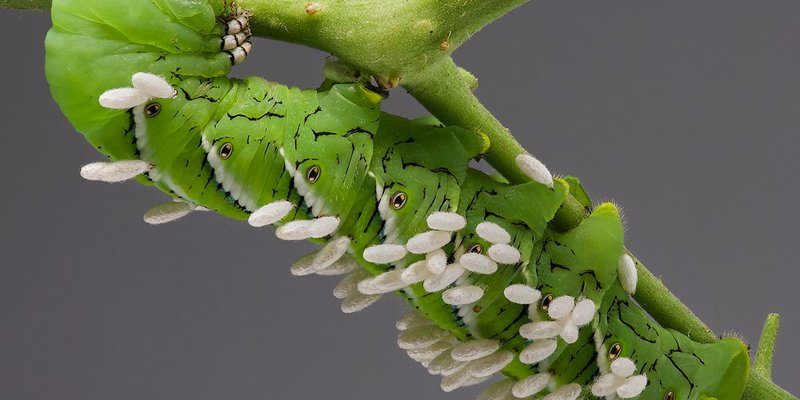
These tiny heroes don’t just buzz around aimlessly; they help control hornworm populations by laying their eggs inside them. When the eggs hatch, they feed on the hornworms’ insides, which sounds a bit gruesome but is nature’s way of keeping the balance. Let’s dive deeper into how these wasps work and how you can make them part of your gardening toolkit.
What Are Hornworms and Why Do They Matter?
Hornworms are the larvae of certain moth species, particularly the tomato hornworm. They are large, green caterpillars that can grow up to 4 inches long. If you spot one, it can be astonishingly hard to miss—until you notice how much damage they can do. They’re notorious for devouring the leaves and fruit of plants like tomatoes, peppers, and eggplants.
Here’s the thing: a small number of hornworms can quickly become a larger infestation if not controlled. You might think they’re adorable little caterpillars, but trust me, they can wreak havoc in your garden. Losing your hard-earned produce can be incredibly disheartening, not to mention costly. That’s why understanding how to manage their populations naturally is key.
How Parasitic Wasps Work
So, what are these parasitic wasps all about? These wasps are generally very small and often go unnoticed. When they find a hornworm, they lay their eggs inside the caterpillar. The wasp larvae hatch and begin to eat the hornworm from the inside out. It sounds like something out of a horror movie, but in the garden, it’s an ecological balancing act.
Once the wasp larvae have matured, they emerge from the hornworm’s body, leaving it lifeless. Imagine this like a drama unfolding in your garden. The wasp larvae are quite efficient, targeting hornworms, and limiting their populations effectively. Using parasitic wasps is like hiring a natural pest control service that takes care of the problem without harming your plants or the environment.
Benefits of Using Parasitic Wasps
Choosing parasitic wasps over chemical pesticides is like opting for a cozy, homemade meal instead of fast food. Here are a few reasons why these little wasps are a great choice for controlling hornworm populations:
- Environmentally Friendly: Parasitic wasps target specific pests without harming beneficial insects that help pollinate your plants.
- Cost-Effective: Once established, these wasps often reproduce in your garden, providing ongoing pest control without continuous purchases of pesticides.
- Safe for Humans and Pets: Unlike chemical options, parasitic wasps won’t pose risks to you, your family, or your pets.
Honestly, once you understand how they work, it’s hard not to see them as the unsung heroes of your garden. Using them can lead to a more sustainable gardening practice, preserving the health of your plants and the ecosystem.
Choosing the Right Parasitic Wasps
Not all wasps are created equal. If you’re considering using parasitic wasps to tackle your hornworm problem, it’s important to choose the right species. Cotesia congregata is one of the best-known wasps for this purpose. It specifically targets hornworms and is generally available through garden supply stores or online.
When selecting your wasps, look for:
- Reputable Suppliers: Ensure you’re buying from trusted sources to get healthy, viable wasps.
- Packaging: Check how they’re packaged; they should come in a way that keeps them safe during shipping.
- Release Instructions: Follow instructions carefully to maximize their effectiveness in your garden.
Let me explain: introducing wasps into your garden isn’t as simple as just letting them fly free. You need to consider the timing and conditions for their best survival.
How to Release Parasitic Wasps in Your Garden
Once you have your parasitic wasps, it’s time to get them into your garden. Here are some steps to ensure successful introduction:
1. Timing Matters: Release the wasps in the early morning or late afternoon when temperatures are lower. This helps them settle into their new environment.
2. Choose the Right Locations: Look for areas where hornworms are likely to be found, typically near tomato and pepper plants.
3. Water the Area: A little moisture helps create a welcoming environment for the wasps.
4. Avoid Chemical Pesticides: For the best results, avoid using any chemical treatments around the time of releasing the wasps. You want them to thrive, not be killed off.
Following these steps helps the wasps establish themselves and start their job of controlling hornworm populations effectively.
Monitoring the Results
After releasing the wasps, it’s time to play the waiting game. Monitoring how things go will give you insights into their effectiveness. Check your plants regularly for signs of hornworm activity and watch for the presence of wasp larvae.
Here’s how to keep track:
- Inspect Leaves: Look for chewed leaves, which indicate hornworm activity.
- Look for Defensive Behavior: Wasps may fly around when disturbed. If you see a lot of wasp activity, they’re likely doing their job!
- Check for Pupal Cases: Mummies, or the cases left behind by wasp larvae, can often be spotted on the hornworms.
Remember, nature takes time. Be patient as the wasps work their magic. You might be surprised by how quickly they get your hornworm problem under control.
What to Do if Wasps Don’t Help
Sometimes, despite your best efforts, the wasps might not completely eliminate the hornworm issue. If you find yourself in this situation, don’t panic! Here are a few alternative approaches you can consider:
1. Manual Removal: Sometimes the old-fashioned way works best. Handpicking hornworms from plants can be effective, especially if you’re diligent.
2. Companion Planting: Planting certain herbs and flowers can deter hornworms. For instance, planting basil near tomatoes can help keep pests at bay.
3. Neem Oil: If the hornworm population is still high, consider using neem oil—it’s a natural pesticide that’s less harmful to beneficial insects compared to chemical alternatives.
These strategies complement the wasps, giving you a rounded approach to pest management.
Using parasitic wasps to control hornworm populations is a fantastic way to manage pests sustainably. They’re like a little army of guardians, helping keep your garden thriving without the need for harmful chemicals. Remember to choose the right wasps, release them properly, and monitor their progress. If all goes well, you should see a healthier garden full of happy plants and fewer pesky hornworms. Happy gardening!

